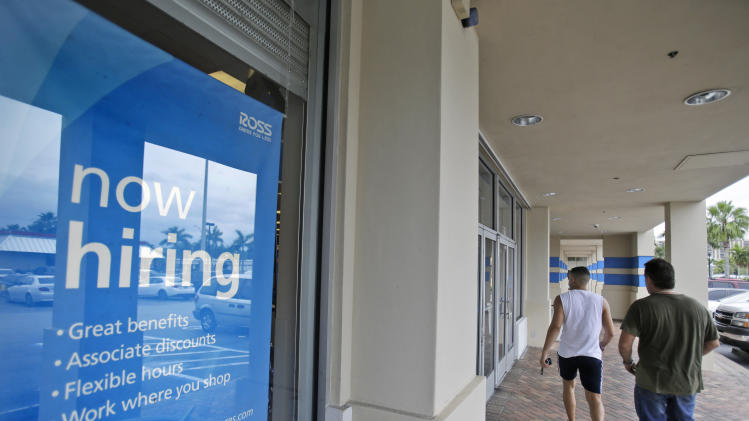FILE – In this May 16, 2014 file photo, shoppers walk past a now hiring sign at a Ross store in North Miami Beach, Fla. The Labor Department releases weekly jobless claims on Thursday, June 12, 2014. (AP Photo/Wilfredo Lee, File)
For the past six years, any change in the Federal Reserve’s low-interest-rate policy was comfortably in the future. But developments within the next few weeks could lead to the kind of policy change many investors have been anticipating, and some have been dreading.
If the government’s next monthly jobs report — due Friday — is as strong as the last few, it could accelerate the Fed’s inevitable decision to start raising rates. And that shift could now come as early as mid-September, when the Fed’s policymaking committee meets next. “Assuming that the upcoming jobs report confirms the recent improving employment trend, the Fed will have room to potentially lay out its transition game plan,” Rick Rieder, a managing director at investing firm BlackRock, wrote recently.
Once the Fed officially shifts its policy, it won’t raise rates right away but will most likely signal hikes are coming. Most analysts think actual hikes would occur about six months after the Fed telegraphs the move. Fed chair Janet Yellen has a press conference scheduled following the mid-September meeting, which could provide an opportunity to thoroughly explain any changes.
What will force the Fed’s hand?
So how many new jobs would it take to force the Fed’s hand? Employers created 209,000 new jobs in July, and the average during the past three months has been 245,000. That’s a robust pace of job growth that rivals the late 1990s, when a booming economy created about 260,000 jobs per month. The latest ADP report (which is considered somewhat unreliable) showed the private sector created a respectable 204,000 jobs in August. Economists are expecting the official government report due Friday to show about 230,000 new jobs. A higher number would certainly signal healthy growth that could warrant a transition to higher interest rates.
Yellen, of course, has a “dashboard” of indicators that includes much more than the number of new jobs, and she’d also want to see improvements in wages, labor-force participation and the number of people out of work for more than six months. Those metrics have generally been weak — accounting for much of the labor-market “slack” Yellen refers to frequently — but each has shown modest signs of improvement lately. If those improvements persist, it will give the Fed further incentive to raise rates.
Rieder expects the first rate hikes as early as March of next year. Others feel the first hike will come later in 2015, with the Fed waiting for more data before it concludes the job market is on its way to fully healing.
Tightening, once it begins, will most likely be very gradual, since the economy is still shaky and vulnerable to shocks. Forecasting firm Macroeconomic Advisors predicts that, by the end of 2016 — when employment ought to be robust and inflation around a manageable 2% — short-term rates, now essentially 0%, will be between 2.5% and 3%. By then, the “equilibrium” short-term rate — the natural market rate, absent extraordinary Fed intervention — ought to be around 3.75%. So the Fed could deliberately keep rates a full percentage point or more below where they’d otherwise be. “We expect such gradualism to be primarily motivated by the [Fed’s] strong desire to avoid disrupting financial markets and the economy,” Macroeconomic Advisers said in a recent research note.
Still, even a gradual change in Fed policy could cause turmoil in the markets. The biggest unanswered question on Wall Street right now is whether investors have adjusted to coming Fed policy changes or have blithely assumed everything will remain hunky-dory, setting themselves up for an unhappy surprise. Since 2009, the Fed’s super-easy policies — including plunging rates and quantitative easing, which is set to expire in October — have coincided with soaring stock prices. Reflating the value of so-called risk assets such as stocks was a big part of the Fed’s overall plan for reviving the economy following the 2007-2009 recession. So if plunging interest rates helped inflate the value of stocks, it stands to reason that rising rates might puncture stock prices.
Higher interest rates don’t have to be bad for stocks — especially if they rise because the economy is getting stronger, which obviously ought to be good for corporate profits. And stocks have held up surprisingly well as quantitative easing draws to a close and the day of short-term rate hikes nears. But that might be due to a short-term focus by traders and investors who don’t want to think too hard about the future. They can’t put it off much longer.

No comments:
Post a Comment